How Automated License Plate Recognition (ALPR) Works
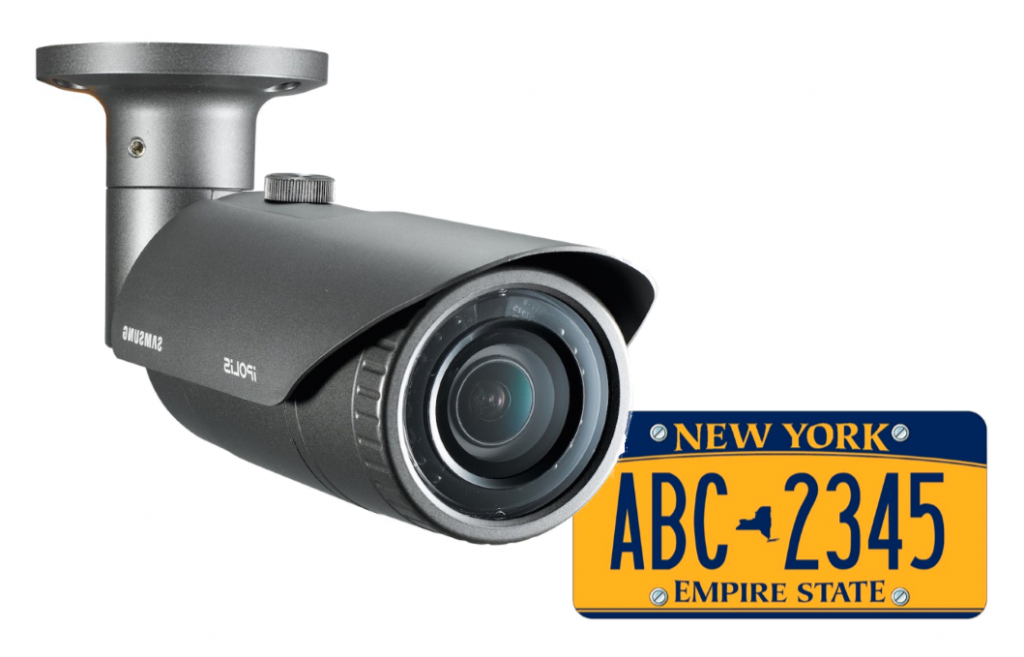
You may not have realized it, but Automated License Plate Recognition (ALPR) technology is all around us. It is used for toll collecting, to control access to parking lots and even to capture criminals. The technology has improved over the years and has become more economical.
Besides the analytic software that converts the image to computer characters, the system requires a good IP camera. It also requires proper lighting and the correct physical placement of the camera.
The analytic conversion software is similar to optical character recognition (OCR) software. ALPR is available as a standalone LPR system or included as an option with some IP camera video management systems.
Here are the details about how the license plate recognition system works.
IP Cameras Capture the License Plate
The IP camera is a very important part of the ALPR system. It is critical that the camera provides the very best image. It has to have the right resolution, and be able to capture the license plate image day or night.
During daytime, when there is enough light, most IP cameras will work, but at night the requirements are more challenging. If there isn’t standard lighting available, IR illumination can be added. This can be a separate light or provided by an IP camera that has a built-in IR illuminator. Many license plates have reflective paint that enhances the number when illuminated by IR. The camera should also support wide dynamic range (WDR) to handle the extreme lighting that may be present. If you would like to capture license plates from oncoming cars, then the IP camera needs the ability to block out headlight glare. For example, the Samsung X-series of IP cameras has Highlight Compensation (HLC) that blocks the glare from the headlights. Here’s an example:
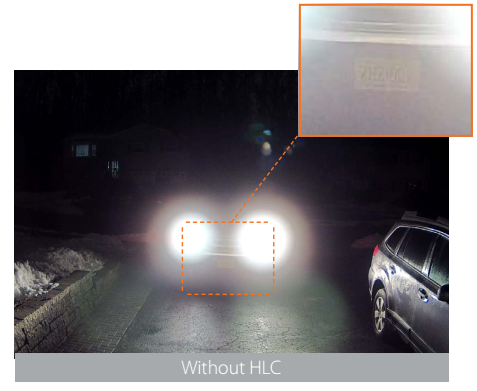
The faster the vehicle moves the more challenging it is to capture and process the license plate images. The IP camera must have a fast frame rate and short shutter time to prevent image smear.
The faster the vehicle moves, the shorter the shutter speed required. In many cases, a shutter speed of less than 1/1000 of a second is required to prevent blurring.
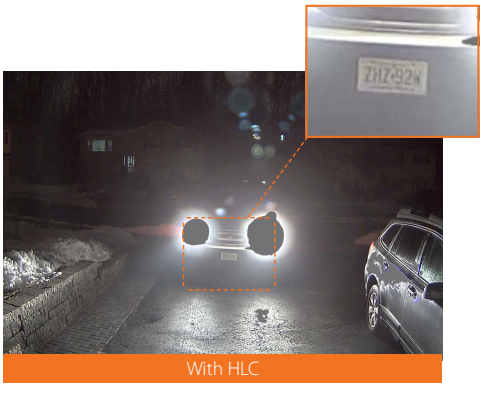
The camera should be positioned so the license plate is not viewed at an extreme angle. In most systems, the camera captures one lane at a time.
The size of the car lane can determine the required camera resolution. The wider the field of view, the higher the resolution required.
Camera Resolution
We need enough resolution so that the license plate reader system can see the characters clearly. Many LPR systems will define the resolution required for their specific system to work reliability. This is usually defined by pixels across the license plate, pixels across a character, or pixels/ft.
People can recognize a blurry character better than a computer. The computer requires more resolution than the human eye. How much resolution is required? For this analysis, it doesn’t matter how large or small the character is. The right resolution is determined by the number of pixels across a character. The camera’s field of view can be adjusted so that the pixels across the characters are correct.
The chart below shows the lettering used on the tail of an aircraft, and according to FAA regulations, is 12-inches high. The chart shows lettering displayed using 100 pixels high, 50 pixels high, 25 pixels high, 12 pixels high, and 6 pixels high resolution.
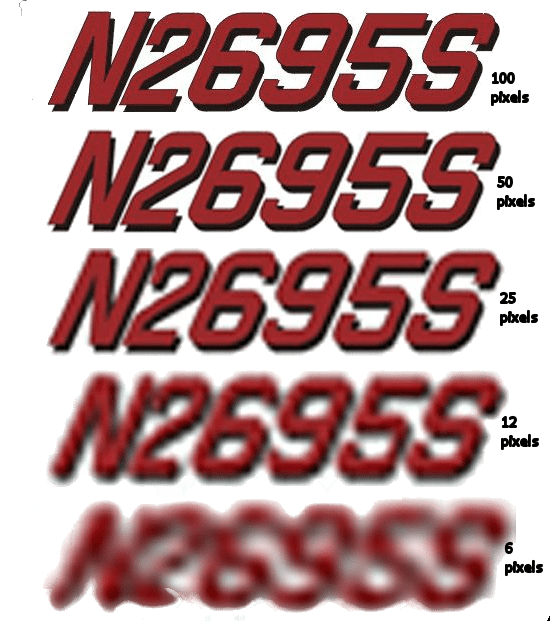
As you can see, the characters that are 12 pixels high are identifiable to a person, but the OCR algorithm requires more resolution. The software will be more reliable with characters defined by 25 vertical pixel resolution. Since these letters are 12 inches tall, we need 25 pixels/ft to read them correctly. We can use this information to determine the right camera resolution for reading license plates.
A typical license plate in the US is 12-inches long. Each character is 2.5 inches high. Since we need 25 vertical pixels across the character, we need a camera that will provide 25 pixels / 2.5 inches or 10 pixels/inch.
Once we know the resolution across the license plate, we can calculate the resolution of the IP camera. Suppose we want to view a standard US highway. The width of a standard highway lane is 12 ft. (3.7 m). To calculate the total horizontal pictures required, we multiply 10 pixels/in. X 12 ft x 12in./ft = 1440 pixels. A 2-Megapixel camera provides 1920 x 1080 resolution, so this is more than adequate to cover the highway. It actually provides a maximum field of view of 16 ft.
We can also calculate the lens we should use. The lens will determine the distance from the camera. We use trigonometry to calculate the angle of the lens we need. Lenses for IP cameras are defined by their “mm” or angle, so it’s easy to select the right lens. For example, a camera with a 20-degree lens can be placed about 46 ft. away from the point where the camera reads the license plate. For more about selecting the right lens, read our article, Calculating What You Can See With Your Camera.
License Plate Recognition Algorithms
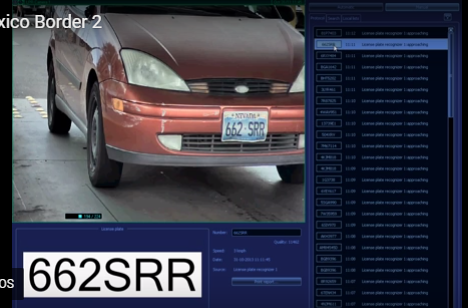
The software that analysis and converts the image to computer data uses a number of different algorithms to provide the conversion.
The primary technology is optical character recognition (OCR). Before using the OCR function, there are a number of preprocessing functions used to prepare the image for OCR.
Preprocessing of LPR Image
- To improve successful recognition, there are several processes used:
- Plate location – This process locates the license plate in the image
- De-skew, orientation, and sizing – The camera can capture a plate at various distances and locations within the field of view. This process corrects the skew, location, and size.
- Filtering – This filtering process removes small spots and anomalies.
- Normalization – License plates can be different colors, brightness, and contrast. The process normalizes the image so it can be used by the OCR function.
- Character Isolation – The process identifies and defines each individual character.
- Pass the processed image to the OCR function
Character Recognition
There are two types of algorithms used by OCR engines. The first technique matches the images. It stores all the pixels and matches the pattern of the image against stored images. The second method extracts features such as lines, curves, and intersects to create a match.
In all cases, the license plate image is converted to a coded computer character. This information can be compared to a database or just recorded for later use.
Applications
ALPR systems are used all over the world. The success of implementation in individual countries depends on the standardizations of the license plates used.
Applications include:
- Parking entry control – A gate controlled by an ALPR system can be used to control access to a garage. A list of allowed tenants can be used to restrict parking lot usage.
- Automated Parking Fee collection – Systems that use ALPR can be used to automatically collect the parking fee. This also requires a database of all people who can use the parking facility.
- Electronic Toll Collection – The ALPR system is usually used as a backup to long range transponders that are in each vehicle. The database is provided by the government so that fees can be billed.
- Housing Area Gate Control – This is similar to parking lot control. A gate is used to control access to a gated community, and automatically opened based on license plate match.
- Stolen Car identification – A list of stolen vehicles can be provided by law enforcement and compared to vehicles on the road.
- Locating Vehicles against watch lists – Locating a criminal, or tracking suspicious persons can be implemented using LPR.
- Traffic enforcement – These systems can be used to capture the license plate of vehicles that go through a red light, or that are speeding.
Summary
Automated or automatic license plate recognition requires a good camera that is designed for the environment. It requires the right resolution based on the size of the lane. The software requires the image to be preprocessed so it can be used by the optical character recognition software. ALPR systems have become more reliable and are now included with some video management recording systems. These systems are also called Car Plate Recognition (CPR), Automatic Vehicle Identification (AVI), or just License Plate Recognition (LPR).
To make sure you get the right system, please contact us at 800-431-1658 in the USA, or at 914-944-3425 everywhere else, or use our contact form.